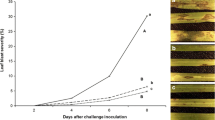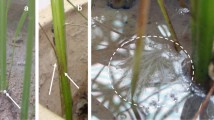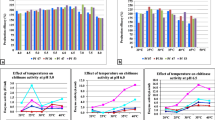Abstract
This paper developed an in vivo bioassay method of determining bioactivity of compounds against Magnaporthe grisea (Hebert) Barr. with barley (Hordeum vulgare L.) plants, instead of rice (Oryza sativa L.) plants. To confirm whether this method could be used to screen active compounds against this fungus or not, experiments were conducted using the five fungicides tricyclazole, kasugamycin, thiophanatemethyl, iprobenfos and salicylic acid with different action modes. The results showed there were close correlation in disease severity and no significant difference in EC50 values between rice and barley, and the coefficients of variations of EC50 values were similar between rice and barley for the four tested fungicides in both detachedleaf-segment and pot-seedling tests. The advantage in bioactivity determination with barley was timesaving. Plant materials could be used at the 1-leaf stage for barley while at the 5-leaf stage for rice. So it shortened about 14 days for the preparation of plant materials for tests.
Zusammenfassung
Die Entwicklung eines Tests zur Bestimmung der biologischen Aktivität von Substanzen gegenüber Magnaporthe grisea (Hebert) Barr. an Gerste (Hordeum vulgare L.) statt Reis (Oryza sativa L.) wird beschrieben. Vier Fungizide mit unterschiedlichen Wirkungsmechanismen, Tricyclazol, Kasugamycin, Thiophanatmethyl und Iprobenfos sowie der Resistenz-induktor Salicylsäure wurden zur Überprüfung der Güte des Biotests verwendet. Die Befallsstärken des Erregers an beiden Testpflanzen korrelierten hoch, während die EC50-Werte nicht zwischen den Pflanzenarten differierten, ebensowenig wie die Korrelationskoeffizienten der EC50-Werte der vier untersuchten Fungizide sowohl im Blattsegment- als auch im Topftest. Der Vorteil der Bestimmung der biologischen Aktivität der Substanzen an Gerste besteht in einer signifikanten Zeitersparnis. Das Pflanzenmaterial kann bei der Gerste im Ein-Blatt-Sta-dium, beim Reis dagegen erst im Fünf-Blatt-Stadium eingesetzt werden, was die Dauer des Tests um zwei Wochen verkürzt.
Similar content being viewed by others
Literature
BAKER, B., P. Zambryski, B. Staskawicz, 1997: Signaling in plantmicrobe interaction. Science 276, 726–733.
CHOI, G.J., S.W. Lee, K.S. Jang., J.S. Kim, K.Y. Choi, J.C. Kim, 2004: Effects of chrysophenol, parietin, and nepodin of Rumex cripus on barley and cucumber powdery mildews. Crop Prot. 23, 1215–1221.
DAAYF, F., A. Schmitt, R.R. Bélanger, 1995: The effects of plant extracts of Reynoutria sachalinensis on powdery mildew development and leaf physiology of long English cucumber. Plant Dis. 79, 577–580.
PENG, Y.L., J. Shishiyama, 1988: Temporal sequence of cytological events in rice leaves infected with Pyricularia oryzae. Can. J. Bot. 66, 730–735.
PENG, Y.L., Y. Shirano, H. Ohta, T. Hibino, K. Tanaka, D. Shibata, 1994: A novel lipoxygenase from rice. Primary structure and specific expression upon incompatible infection with rice blast fungus. J. Biol. Chem. 269, 3755–3761.
ROSSMAN, A.Y., R.J. Howard, B. Valent, 1990: Pyricularia grisea, the correct name for the rice blast disease fungus. Mycologia 82, 509–512.
VALENT, B., L.F. Farrall, G. Chumely, 1991: Magnaporthe grisea genes for pathogenicity and virulence identified through a series of backcrosses. Genetics 127, 87–101.
ZHANG, C.Q., M.G. Zhou, N. Xue, 2005: Sensitivity test method and resistance risk assessment of Magnaporthe grisea to tricyclazole. Chin. J. Rice Sci. 19, 79–84.
Author information
Authors and Affiliations
Corresponding author
Rights and permissions
About this article
Cite this article
Yang, X.J., Ma, X.X., Yang, L.J. et al. A novel bioassay method: Determining bioactivity of compounds against rice blast (Magnaporthe grisea) with barley plants. J Plant Dis Prot 114, 228–231 (2007). https://doi.org/10.1007/BF03356222
Received:
Accepted:
Published:
Issue Date:
DOI: https://doi.org/10.1007/BF03356222




